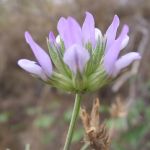| Common Name: |
Scurf Pea |
| Other Names: |
Malay Tea, Babchi |
| Botanical Name: |
Psoralea corylifolia |
| Genus: |
Psoralea |
| Family: |
Papilionaceae |
| Native Location: |
Arable land in Asia (mainly in India and Iran). |
| Cultivation: |
Well-drained soil in sun. |
| Propagation: |
By seed sown in spring, soaked in hot water to speed germination. |
| Harvest: |
Seeds are collected when ripe and dried for use in decoctions. |
| Height: |
90cm (3ft) |
| Width: |
10-20cm (4-8in) |
| Hardiness: |
Min. 10-15°C (50-59°F). |
| Parts Used: |
Seeds (bu gu zhi) |
| Properties: |
A bitter, astringent, warming herb that stimulates kidney (Yang) energy, and has diuretic and anti-bacterial effects. |
| Medicinal Uses: |
Internally, in Chinese medicine, for disorders related to kidney weakness, such as early-morning diarrhea, urinary complaints, impotence, asthma, and baldness. May be mixed with salt to increase action on kidneys. Injection of psoralea extract has been used with considerable success in Chinese reseach to treat hair loss. Internally and externally, in Ayurvedic medicine, for skin disease and hair loss. |
| Bibliography: |
Encyclopedia of Herbs by Deni Brown Copyright © 1995, 2001 Dorling Kindersley Limited Pp 334-335 |

